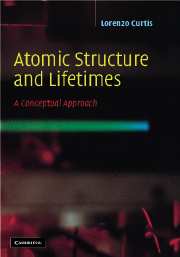Book contents
- Frontmatter
- Contents
- Preface
- List of physical constants and useful interrelations
- 1 Introduction
- 2 Semiclassical conceptual models
- 3 Semiempirical parametrization of energy-level data
- 4 The vector model of angular momentum
- 5 The intermediate coupling model
- 6 Electric dipole radiation
- 7 Line strengths in two-valence-electron systems
- 8 Magnetic dipole transitions
- 9 Absorption of radiation
- 10 Time-resolved measurements
- 11 Hyperfine structure
- 12 Electrostatic polarizabilities and long-range interactions
- 13 Coherence and anisotropic excitation
- References
- Index
9 - Absorption of radiation
Published online by Cambridge University Press: 06 July 2010
- Frontmatter
- Contents
- Preface
- List of physical constants and useful interrelations
- 1 Introduction
- 2 Semiclassical conceptual models
- 3 Semiempirical parametrization of energy-level data
- 4 The vector model of angular momentum
- 5 The intermediate coupling model
- 6 Electric dipole radiation
- 7 Line strengths in two-valence-electron systems
- 8 Magnetic dipole transitions
- 9 Absorption of radiation
- 10 Time-resolved measurements
- 11 Hyperfine structure
- 12 Electrostatic polarizabilities and long-range interactions
- 13 Coherence and anisotropic excitation
- References
- Index
Summary
Backward, turn backward, O time in your flight. Make me a child again, just for tonight.
–Elizabeth Akers AllenSince the time of Kirchhoff it has been known that, when light is passed through an atomic gas, those wavelengths are observed that would be emitted if the gas were incandescent. If the gas is sufficiently cold, then the wavelengths observed are limited to ground-state transitions. As the temperature of the sample is elevated, wavelengths corresponding to transitions between excited states become absorbing, and balances between emission and absorption occur.
The study of the central wavelengths of emission lines or absorption notches is known as first-order spectroscopy, and it provides information on the energy-level structure of the atom. The study of the shape of these lines in frequency space is known as second-order spectroscopy, and provides information on the lifetime of the level and the collision rates and temperature of the gas. Thus, whereas first-order spectroscopy shows that emission and absorption measurements yield the same central wavelengths, second-order spectroscopy shows that the natural linewidth for emission and absorption are both specified by the level lifetime, and that the intensity of emission and absorption features both involve the linestrength factor (through the emission transition probability rate and the absorption oscillator strength).
The connection between the lifetime and the linewidth can be made plausible by a simple semiclassical model. When an electron is excited to a specific orbit in an atom, its binding energy is established through the exchange of virtual photons with the effective central core. If the perturbations that eventually cause the electron to make a transition from that orbit are weak, the meanlife will be long.
- Type
- Chapter
- Information
- Atomic Structure and LifetimesA Conceptual Approach, pp. 179 - 193Publisher: Cambridge University PressPrint publication year: 2003



